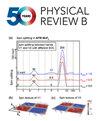利用原位多反射布拉格相干x射线衍射成像研究钛酸锶微晶中的低温态
IF 3.7
2区 物理与天体物理
Q1 Physics and Astronomy
引用次数: 0
摘要
钛酸锶是一种典型的量子顺电氧化物材料,已被广泛用于块体和薄膜研究。在 105 K 时,它表现出众所周知的立方到四方的反铁电体相变,其特征是氧八面体的旋转。在较低温度下可能发生的第二次相变受到量子波动的抑制,从而阻碍了铁电秩序的形成。然而,最近的研究表明,通过诱导应变等手段,铁电有序可以在低温下建立。在这里,我们使用多反射布拉格相干 X 射线衍射成像技术测量了两种钛酸锶微晶在低温下的应变和旋转张量。我们观察到微晶中的位错和包涵状杂质引起的应变。根据径向幅度图,这些应变的幅度随着温度的降低而增大并扩散。皮尔逊相关热图显示了 50 K 时的结构转变,这可能是在应变存在的情况下形成的低温铁电相。我们没有观察到与 105 K 时四方相变相关的局部应变的任何变化。本文章由计算机程序翻译,如有差异,请以英文原文为准。
Low-temperature state in strontium titanate microcrystals using in situ multireflection Bragg coherent x-ray diffraction imaging
Strontium titanate is a classic quantum paraelectric oxide material that has been widely studied in bulk and thin films. It exhibits a well-known cubic-to-tetragonal antiferrodistortive phase transition at 105 K, characterized by the rotation of oxygen octahedra. A possible second phase transition at lower temperature is suppressed by quantum fluctuations, preventing the onset of ferroelectric order. However, recent studies have shown that ferroelectric order can be established at low temperatures by inducing strain and other means. Here, we used multireflection Bragg coherent x-ray diffraction imaging to measure the strain and rotation tensors for two strontium titanate microcrystals at low temperature. We observe strains induced by dislocations and inclusion-like impurities in the microcrystals. Based on radial magnitude plots, these strains increase in magnitude and spread as the temperature decreases. Pearson's correlation heat maps show a structural transition at 50 K, which could possibly be the formation of a low-temperature ferroelectric phase in the presence of strain. We do not observe any change in local strains associated with the tetragonal phase transition at 105 K. Published by the American Physical Society 2025
求助全文
通过发布文献求助,成功后即可免费获取论文全文。
去求助
来源期刊

Physical Review B
物理-物理:凝聚态物理
CiteScore
6.70
自引率
32.40%
发文量
0
审稿时长
3.0 months
期刊介绍:
Physical Review B (PRB) is the world’s largest dedicated physics journal, publishing approximately 100 new, high-quality papers each week. The most highly cited journal in condensed matter physics, PRB provides outstanding depth and breadth of coverage, combined with unrivaled context and background for ongoing research by scientists worldwide.
PRB covers the full range of condensed matter, materials physics, and related subfields, including:
-Structure and phase transitions
-Ferroelectrics and multiferroics
-Disordered systems and alloys
-Magnetism
-Superconductivity
-Electronic structure, photonics, and metamaterials
-Semiconductors and mesoscopic systems
-Surfaces, nanoscience, and two-dimensional materials
-Topological states of matter
 求助内容:
求助内容: 应助结果提醒方式:
应助结果提醒方式:


